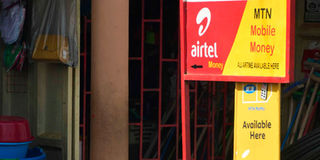Over half of mobile money transactions in 2019 were digital

Gone beyond: Mobile money has gone beyond basic services to utility bill payments, merchant payments, e-commerce and health among others, which could explain the rapid growth. PHOTO BY EDAR R BATTE
What you need to know:
- In digital form. A larger proportion of money, according the GSMA report, is entering and leaving the system in digital form, rather than cash conversions.
- According to the report, in 2019, there was a shift away from cash to digital payments, especially for services like school fees, e-commerce, remittances, savings, credit, pay-as-you-go and utilities among others.
More than half of the global transactions on mobile money in 2019 were done digitally as opposed to converting money to cash.
According to the 2019 State of the Industry Report on Mobile Money by Global System for Mobile Communications Association (GSMA), digital transactions represented majority of mobile money flows.
“For the first time, digital transactions represent the majority 57 per cent of mobile money transaction value. A larger proportion of money is entering and leaving the system in digital form, rather than cash conversions,” the report reads in part.
Essentially, this signifies a heightened level of acceptance of digitisation, which is a step closer to a cashless digital economy.
According to the report, in 2019, there was a shift away from cash to digital payments, especially for services like school fees, e-commerce, remittances, savings, credit, pay-as-you-go and utilities among others.
There is currently renewed need for a cashless economy among different countries, especially because of the ongoing Covid-19 pandemic, whose risk of spreading is increased by movement of paper money.
Interoperability
The findings peg the increase in digital transactions to the industry becoming a more integral part of the financial ecosystem through interoperability and lower barriers to third-party integration.
For instance, on average, mobile money providers with bank integrations are connected to 13 banks, which has dramatically increased the volumes moving between mobile money and banking systems.
Mobile money-to-bank account interoperability has grown, increasing by 34 per cent year on year in 2019.
Additionally, mobile money-enabled international remittances have been flourishing, with $7.3b processed in 2019, compared to $5.5b in 2018.
Increased user trust as well as augmenting mobile money accounts, which the report highlighted went over one billion in 2019 with about 372m active on a three month basis, has promoted digital transacting.
Sub-Saharan Africa, the report says, is the epicenter of mobile money, adding over 50 million accounts in 2019.
This was driven by strong growth in western Africa (21 million new accounts) and central Africa (six million new as well as steady growth in eastern Africa (22 million new accounts).
Shift from basics
Ms Rashmi Pillai, the Financial Sector Deepening Uganda, executive director, acknowledged digital transactions are rising in Uganda, beyond cash-in and cash-out.
This, she says, is because of the shift from basic mobile money functions to emerging usage such as utility bill payments, merchant payments, e-commerce and health among others.
“Users are increasingly getting more comfortable with in-ecosystem payments fueled by serious campaigns by telecoms and Fintechs,” she says.




